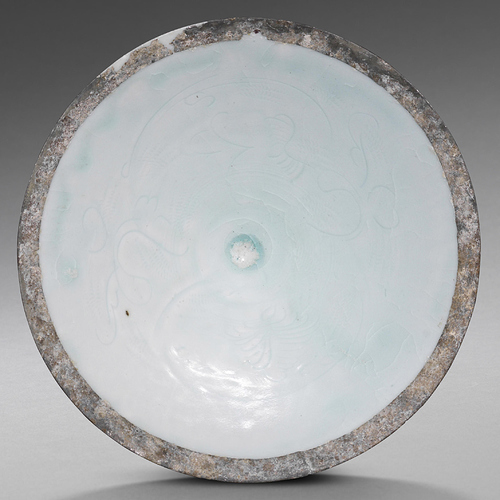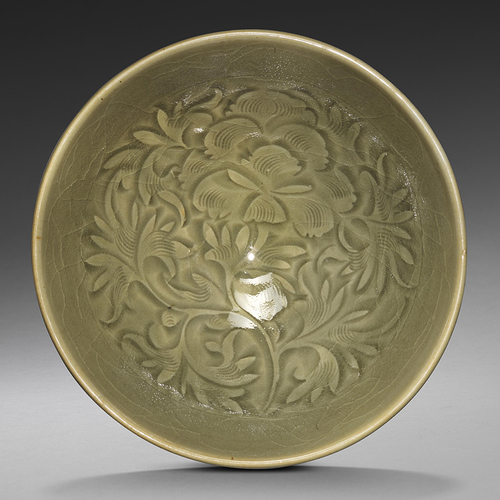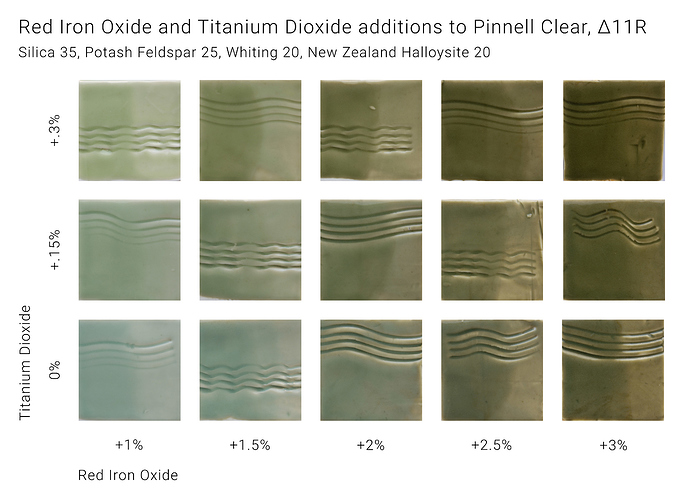Chinese Celadon
Following images from Bonham’s 2014 auction, The Feng Wen Tang Collection of Early Chinese Ceramics
A Qingbai incised conical bowl. Glaze analyses from Nigel Wood’s Chinese Glazes show that these qingbai glazes typically contained less than 1% iron.
A Fine Yaozhou Celadon ‘Peony’ Carved Bowl. Yaozhou celadons typically contained 1-2% iron as well as other impurities, notably titania.
There’s a great range of colour in Chinese celadons. In traditional celadons, color is mostly the result of materials containing naturally-occurring iron being fired in a reduction atmosphere, with the color modified by the balance of other oxides in the glaze as well as the underlying clay body. Relatively small amounts of titania, manganese, copper and even cobalt can affect the color in significant ways. Ancient kilns like Yue, Hutian, Longquan, and Yaozhou became associated with certain colors and qualities of celadon, as the materials used at those kiln sites naturally contained particular blends of oxides. In Jingdezhen, celadon glazes seem to have evolved from fairly simple geographically specific material-based recipes (e.g. 10 parts glaze stone from Yaoli, 1 part glaze ash from Leping) to extremely refined and intentional recipes with similar base glazes that incorporate additional materials for their specific ability to modify color. This lead to glazes named not just for kiln sites but also specific colors and qualities: 天青 (sky blue with a small < .2% addition of cobalt),豆青(”bean” celadon pure green iron celadon),影青(”shadow” lake-green),粉青,玉青 (jade celadon),冬青 (winter green),鸭蛋青 (bright duck-egg green), just to name a few.
But celadons in the Song dynasty were mostly restricted to local materials. Thus if your local clay and glaze stone contained only trace amounts of titania and low amounts of iron (such as in towns near Jingdezhen), then you could produce the famously pure blueish-green qingbai glazes. While if you were in the Northern Yaozhou kilns where materials naturally contained more titania, your celadons would tend towards olive-green. (These are greatly over-simplified and generalized statements. Regarding Yaozhou celadons, in Chinese Glazes, Chapter 6, The Stonewares of North China, Woods also mentions the blueish-grey glazes of Yaozhou, as well as the possible influence of coal firing on the color of Yaozhou celadons.)
Part of the beauty of Chinese ceramics is the ability of those ancient potters to reveal the beauty of their local materials, and how the resulting aesthetic of each kiln’s wares was in large part driven by the nature of those materials.
Of course, these days most of us make glazes by blending various “standardized” materials, with color variations resulting from additional coloring oxides.
The following test is a simple biaxial blend showing the influence of iron and titania on the color of a base glaze. Pinnell Clear is used rather than the traditional Leach 4321. Further tests could be done using small amounts of manganese, copper and cobalt, as well as varying the fluxes and silica:alumina ratio. For this test Grolleg was substituted with New Zealand Halloysite, but the recipe was not adjusted to account for the slightly different chemistry. For this test it is important that the base glaze has as little titania as possible, so it’s best not to use “dirtier” clays. The test tiles are made from Jingdezhen “super-white” porcelain, which serves as a good blank canvas for the glaze colors. These glazes look quite different on dirtier porcelains and stoneware.
Blue Celadon Recipes
Blue celadons require less than 1% iron and the lowest possible amount of titanium, so low-titania kaolins like Grolleg and New Zealand Halloysite are often used. These glazes should be fired in moderate to strong reduction. Additions of barium and tin have been shown to improve glaze color.
https://glazy.org/recipes/2894
https://glazy.org/recipes/2895
Green Celadon Recipes
Green celadons can be easily made by using a base clear recipe and adding 1-2% iron oxide. The simplest example is the classic Leach 4321 with 2% red iron oxide.
https://glazy.org/recipes/3263
https://glazy.org/recipes/2930
Yellow Celadon Recipes
So-called “yellow” celadon are somewhat related to teadust and other crystallizing iron glazes. David Leach Yellow Celadon will give a mustard color in cone 9-10, but fire to a typical celadon at cone 12.





